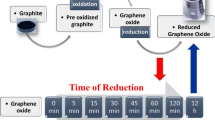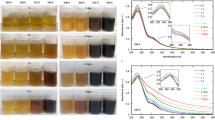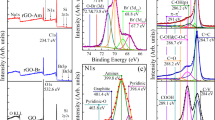Abstract
The excellent electrical, optical and mechanical properties of graphene have driven the search to find methods for its large-scale production, but established procedures (such as mechanical exfoliation or chemical vapour deposition) are not ideal for the manufacture of processable graphene sheets. An alternative method is the reduction of graphene oxide, a material that shares the same atomically thin structural framework as graphene, but bears oxygen-containing functional groups. Here we use molecular dynamics simulations to study the atomistic structure of progressively reduced graphene oxide. The chemical changes of oxygen-containing functional groups on the annealing of graphene oxide are elucidated and the simulations reveal the formation of highly stable carbonyl and ether groups that hinder its complete reduction to graphene. The calculations are supported by infrared and X-ray photoelectron spectroscopy measurements. Finally, more effective reduction treatments to improve the reduction of graphene oxide are proposed.
This is a preview of subscription content, access via your institution
Access options
Subscribe to this journal
Receive 12 print issues and online access
$259.00 per year
only $21.58 per issue
Buy this article
- Purchase on Springer Link
- Instant access to full article PDF
Prices may be subject to local taxes which are calculated during checkout





Similar content being viewed by others
References
Stankovich, S. et al. Graphene-based composite materials. Nature 442, 282–286 (2006).
Szabó, T. et al. Evolution of surface functional groups in a series of progressively oxidized graphite oxides. Chem. Mater. 18, 2740–2749 (2006).
Wang, X., Zhi, L. & Mullen, K. Transparent, conductive graphene electrodes for dye-sensitized solar cells. Nano Lett. 8, 323–327 (2007).
Becerril, H. A. et al. Evaluation of solution-processed reduced graphene oxide films as transparent conductors. ACS Nano 2, 463–470 (2008).
Eda, G., Fanchini, G. & Chhowalla, M. Large-area ultrathin films of reduced graphene oxide as a transparent and flexible electronic material. Nature Nanotech. 3, 270–274 (2008).
Mattevi, C. et al. Evolution of electrical, chemical, and structural properties of transparent and conducting chemically derived graphene thin films. Adv. Funct. Mater. 19, 2577–2583 (2009).
Jung, I., Dikin, D. A., Piner, R. D. & Ruoff, R. S. Tunable electrical conductivity of individual graphene oxide sheets reduced at ‘low’ temperatures. Nano Lett. 8, 4283–4287 (2008).
Gómez-Navarro, C. et al. Electronic transport properties of individual chemically reduced graphene oxide sheets. Nano Lett. 7, 3499–3503 (2007).
Neto, A. H. C., Guinea, F., Peres, N. M. R., Novoselov, K. S. & Geim, A. K. The electronic properties of graphene. Rev. Mod. Phys. 81, 109–162 (2009).
Du, X., Skachko, I., Barker, A. & Andrei, E. Y. Approaching ballistic transport in suspended graphene. Nature Nanotech. 3, 491–495 (2008).
Stankovich, S. et al. Synthesis of graphene-based nanosheets via chemical reduction of exfoliated graphite oxide. Carbon 45, 1558–1565 (2007).
Bourlinos, A. B. et al. Graphite oxide: chemical reduction to graphite and surface modification with primary aliphatic amines and amino acids. Langmuir 19, 6050–6055 (2003).
Hyeon-Jin, S. et al. Efficient reduction of graphite oxide by sodium borohydride and its effect on electrical conductance. Adv. Funct. Mater. 19, 1987–1992 (2009).
Lerf, A., He, H., Forster, M. & Klinowski, J. Structure of graphite oxide revisited. J. Phys. Chem. B 102, 4477–4482 (1998).
Szabó, T., Berkesi, O. & Dékány, I. DRIFT study of deuterium-exchanged graphite oxide. Carbon 43, 3186–3189 (2005).
Fuente, E., Menendez, J. A., Diez, M. A., Suarez, D. & Montes-Moran, M. A. Infrared spectroscopy of carbon materials: a quantum chemical study of model compounds. J. Phys. Chem. B 107, 6350–6359 (2003).
Nakajima, T. & Matsuo, Y. Formation process and structure of graphite oxide. Carbon 32, 469–475 (1994).
Ulrich, H. & Rudolf, H. Über die säurenatur und die methylierung von graphitoxyd. Ber. Dtsch Chem. Ges. 72, 754–771 (1939).
Scholz, W. & Boehm, H. P. Untersuchungen am graphitoxid. VI. Betrachtungen zur struktur des graphitoxids. Z. Anorg. Allg. Chem. 369, 327–340 (1969).
Hontoria-Lucas, C., López-Peinado, A. J., de López-González, J. D., Rojas-Cervantes, M. L. & Martín-Aranda, R. M. Study of oxygen-containing groups in a series of graphite oxides: physical and chemical characterization. Carbon 33, 1585–1592 (1995).
Brodie, B. C. On the atomic weight of graphite. Phil. Trans. R. Soc. Lond. 149, 249–259 (1859).
Staudenmaier, L. Verfahren zur darstellung der graphitsaure. Ber. Dtsch Chem. Ges. 31, 1481–1487 (1898).
Hummers, W. S., & Offeman, R. E. Preparation of graphitic oxide. J. Am. Chem. Soc. 80, 1339 (1958).
Dreyer, D. R., Park, S., Bielawski, C. W. & Ruoff, R. S. The chemistry of graphene oxide. Chem. Soc. Rev. 38, 228–240 (2010).
Cassagneau, T., Guerin, F. & Fendler, J. H. Preparation and characterization of ultrathin films layer-by-layer self-assembled from graphite oxide nanoplatelets and polymers. Langmuir 16, 7318–7324 (2000).
Szabó, T., Tombácz, E., Illés, E. & Dékány, I. Enhanced acidity and pH-dependent surface charge characterization of successively oxidized graphite oxides. Carbon 44, 537–545 (2006).
Cai, W. et al. Synthesis and solid-state NMR structural characterization of 13C-labeled graphite oxide. Science 321, 1815–1817 (2008).
He, H., Klinowski, J., Forster, M. & Lerf, A. A new structural model for graphite oxide. Chem. Phys. Lett. 287, 53–56 (1998).
Hadzi, D. & Novak, A. Infra-red spectra of graphitic oxide. Trans. Faraday Soc. 51, 1614–1620 (1955).
Wang, S. et al. High mobility, printable, and solution-processed graphene electronics. Nano Lett. 10, 92–98 (2010).
López, V. et al. Chemical vapor deposition repair of graphene oxide: a route to highly-conductive graphene monolayers. Adv. Mater. 21, 4683–4686 (2009).
Rubin, Y., Knobler, C. B. & Diederich, F. Precursors to the cyclo[n]carbons: from 3,4-dialkynyl-3-cyclobutene-1,2-diones and 3,4-dialkynyl-3-cyclobutene-1,2-diols to cyclobutenodehydroannulenes and higher oxides of carbon. J. Am. Chem. Soc. 112, 1607–1617 (2002).
Ravagnan, L. et al. Cluster-beam deposition and in situ characterization of carbyne-rich carbon films. Phys. Rev. Lett. 89, 285506 (2002).
Amanda, S. B. & Ian, K. S. Thermal stability of graphene edge structure and graphene nanoflakes. J. Chem. Phys. 128, 094707 (2008).
Jin, C., Lan, H., Peng, L., Suenaga, K. & Iijima, S. Deriving carbon atomic chains from graphene. Phys. Rev. Lett. 102, 205501 (2009).
van Duin, A. C. T., Dasgupta, S., Lorant, F. & Goddard, W. A. ReaxFF: a reactive force field for hydrocarbons. J. Phys. Chem. A 105, 9396–9409 (2001).
Chenoweth, K., Cheung, S., van Duin, A. C. T., Goddard, W. A. & Kober, E. M. Simulations on the thermal decomposition of a poly(dimethylsiloxane) polymer using the ReaxFF reactive force field. J. Am. Chem. Soc. 127, 7192–7202 (2005).
Chenoweth, K., van Duin, A. C. T. & Goddard, W. A. ReaxFF reactive force field for molecular dynamics simulations of hydrocarbon oxidation. J. Phys. Chem. A 112, 1040–1053 (2008).
Kresse, G. & Furthmüller, J. Efficient iterative schemes for ab initio total-energy calculations using a plane-wave basis set. Phys. Rev. B 54, 11169–11186 (1996).
Kresse, G. & Furthmüller, J. Efficiency of ab-initio total energy calculations for metals and semiconductors using a plane-wave basis set. Comput. Mater. Sci. 6, 15–50 (1996).
Kresse, G. & Joubert, D. From ultrasoft pseudopotentials to the projector augmented-wave method. Phys. Rev. B 59, 1758–1775 (1999).
Perdew, J. P., Burke, K. & Ernzerhof, M. Generalized gradient approximation made simple. Phys. Rev. Lett. 77, 3865–3868 (1996).
Zhang, J. et al. Surface-modified carbon nanotubes catalyze oxidative dehydrogenation of n-butane. Science 322, 73–77 (2008).
Acknowledgements
We acknowledge support from the National Science Foundation (NSF) and Nanoelectronic Research Initiative through the Brown University Materials Research Science and Engineering Center program and from the NSF through grants CMMI-0825771 and CMMI-0855853. We thank N. Medhekar, R. Grantab and I. Milas for discussions and suggestions. Computational support for this research was provided by the grant TG-DMR090098 from the TeraGrid advanced support program and the Center for Computation and Visualization at Brown University. M.C. and C.M. acknowledge financial support from the Jacobs Chair Funds at Rutgers University and an NSF CAREER Award (ECS 0543867). The work at University of Texas Dallas was supported by the SWAN-NRI program and Texas Instruments.
Author information
Authors and Affiliations
Contributions
V.B.S. and M.C. conceived the project, A.B. and V.B.S. conducted the MD simulations and first-principles calculations with input from C.M. and M.C., M.A and Y.C. performed the FTIR spectroscopy measurements and analysis, M.C., C.M. and V.B.S. wrote the manuscript with input from Y.C. and M.A. All of the authors read and approved the contents of the manuscript prior to submission. A.B. and C.M. contributed equally to this work.
Corresponding author
Ethics declarations
Competing interests
The authors declare no competing financial interests.
Supplementary information
Supplementary information
Supplementary information (PDF 6704 kb)
Rights and permissions
About this article
Cite this article
Bagri, A., Mattevi, C., Acik, M. et al. Structural evolution during the reduction of chemically derived graphene oxide. Nature Chem 2, 581–587 (2010). https://doi.org/10.1038/nchem.686
Received:
Accepted:
Published:
Issue Date:
DOI: https://doi.org/10.1038/nchem.686
This article is cited by
-
Synthesis of Bupivacaine Adsorbed Reduced Graphene Oxide and Its In-Vitro Local Anesthetic, Enhanced Antimicrobial Activity Against Dental Implant Pathogens
Journal of Cluster Science (2024)
-
Defects mediated weak ferromagnetism in Zn1−yCyO (0.00 ≤ y ≤ 0.10) nanorods semiconductors for spintronics applications
Scientific Reports (2023)
-
Graphene oxide for photonics, electronics and optoelectronics
Nature Reviews Chemistry (2023)
-
Rapid microwave reduction of electrochemically-derived graphene oxide for high-crystalline graphene membranes
Science China Materials (2023)
-
A new insight into the electrochemical activation of passive graphene oxide by reversible anodic cycles: surface characterization and electrochemical properties
Journal of Solid State Electrochemistry (2023)



